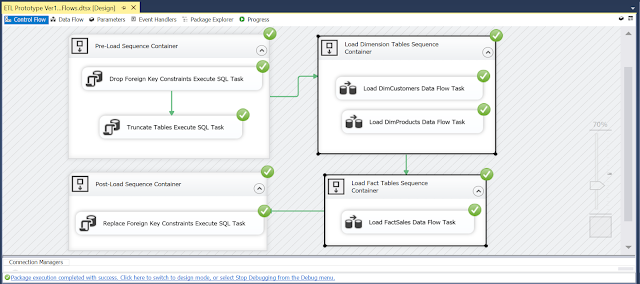What is ETL ?
ETL (Extract, Transform and Load) is a process in data warehousing responsible for pulling data out of the source systems and placing it into a data warehouse. ETL involves the following tasks:
- Extract is the process of reading data from a database.
- Transform is the process of converting the extracted data from its previous form into the form it needs to be in so that it can be placed into another database. Transformation occurs by using rules or lookup tables or by combining the data with other data.
- Load is the process of writing the data into the target database.
This demo shows how to create a SQL based ETL script.
*Note: The source and destination database need to be attached and created before executing the following script.
--****************** [ DWAdventureWorksLT2012V1 ETL Code ] *********************--
-- This file will flush and fill the sales data mart in the DWAdventureWorksLT2012V1 database
--*******************************************************************************-
Use DWAdventureWorksLT2012V1;
go
--********************************************************************--
-- Drop Foreign Key Constraints
--********************************************************************--
ALTER TABLE dbo.FactSales DROP CONSTRAINT
fkFactSalesToDimProducts;
ALTER TABLE dbo.FactSales DROP CONSTRAINT
fkFactSalesToDimCustomers;
ALTER TABLE dbo.FactSales DROP CONSTRAINT
fkFactSalesOrderDateToDimDates;
ALTER TABLE dbo.FactSales DROP CONSTRAINT
fkFactSalesShipDateDimDates;
--********************************************************************--
-- Clear Table Data
--********************************************************************--
TRUNCATE TABLE dbo.FactSales;
TRUNCATE TABLE dbo.DimCustomers;
TRUNCATE TABLE dbo.DimProducts;
--********************************************************************--
-- Fill Dimension Tables
--********************************************************************--
-- DimCustomers
INSERT INTO [DWAdventureWorksLT2012V1].[dbo].[DimCustomers]
( [CustomerID]
, [CompanyName]
, [ContactFullName]
)
SELECT
[CustomerID] = T1.CustomerID
, [CompanyName] = Cast(CompanyName as nvarchar(200))
, [ContactFullName] = Cast([FirstName] + ' ' + [LastName] as nvarchar(200))
FROM [AdventureWorksLT2012].[SalesLT].[Customer] as T1
go
-- DimProducts
INSERT INTO [DWAdventureWorksLT2012V1].[dbo].[DimProducts]
( [ProductID]
, [ProductName]
, [ProductColor]
, [ProductListPrice]
, [ProductSize]
, [ProductWeight]
, [ProductCategoryID]
, [ProductCategoryName]
)
SELECT
[ProductID] = T1.[ProductID]
, [ProductName] = T1.[Name]
, [ProductColor] = IsNull( Cast( T1.[Color] as nvarchar(50)), 'Not Defined')
, [ProductListPrice] =T1.[ListPrice]
, [ProductSize] = IsNull( T1.[Size], -5)
, [ProductWeight] = T1.[Weight]
, [ProductCategoryID] = T2.[ProductCategoryID]
, [ProductCategoryName] = T2.[Name]
FROM [AdventureWorksLT2012].[SalesLT].[Product] as T1
JOIN [AdventureWorksLT2012].[SalesLT].[ProductCategory] as T2
ON T1.ProductCategoryID = T2.ProductCategoryID
go
--********************************************************************--
-- Fill Fact Tables
--********************************************************************--
-- Fill Fact Sales
INSERT INTO [DWAdventureWorksLT2012V1].[dbo].[FactSales]
( [SalesOrderID]
, [SalesOrderDetailID]
, [CustomerKey]
, [ProductKey]
, [OrderDateKey]
, [ShipDateKey]
, [OrderQty]
, [UnitPrice]
, [UnitPriceDiscount]
)
SELECT
[SalesOrderID] = T1.[SalesOrderID]
, [SalesOrderDetailID] = T1.[SalesOrderDetailID]
, [CustomerKey]=T3.[CustomerKey]
, [ProductKey] = T4.[ProductKey]
, [OrderDateKey] = T5.[CalendarDateKey]
, [ShippedDateKey] = T6.[CalendarDateKey]
, [OrderQty] = T1.[OrderQty]
, [UnitPrice] = T1.[UnitPrice]
, [UnitPriceDiscount] = T1.[UnitPriceDiscount]
FROM [AdventureWorksLT2012].[SalesLT].[SalesOrderDetail] as T1
JOIN [AdventureWorksLT2012].[SalesLT].[SalesOrderHeader] as T2
ON T1.[SalesOrderID] = T2.[SalesOrderID]
JOIN [DWAdventureWorksLT2012V1].[dbo].[DimCustomers] as T3
ON T2.[CustomerID] = T3.[CustomerID]
JOIN [DWAdventureWorksLT2012V1].[dbo].[DimProducts] as T4
ON T4.[ProductID] = T1.[ProductID]
JOIN [DWAdventureWorksLT2012V1].[dbo].[DimDates] as T5
ON Cast(T5.CalendarDate as Date) = Cast(T2.[OrderDate] as Date)
JOIN [DWAdventureWorksLT2012V1].[dbo].[DimDates] as T6
ON Cast(T6.CalendarDate as Date) = Cast(T2.[ShipDate] as Date)
go
--********************************************************************--
-- Replace Foreign Key Constraints
--********************************************************************--
ALTER TABLE dbo.FactSales ADD CONSTRAINT
fkFactSalesToDimProducts FOREIGN KEY (ProductKey)
REFERENCES dbo.DimProducts
(ProductKey);
ALTER TABLE dbo.FactSales ADD CONSTRAINT
fkFactSalesToDimCustomers FOREIGN KEY (CustomerKey)
REFERENCES dbo.DimCustomers (CustomerKey);
ALTER TABLE dbo.FactSales ADD CONSTRAINT
fkFactSalesOrderDateToDimDates FOREIGN KEY (OrderDateKey)
REFERENCES dbo.DimDates(CalendarDateKey);
ALTER TABLE dbo.FactSales ADD CONSTRAINT
fkFactSalesShipDateDimDates FOREIGN KEY (ShipDateKey)
REFERENCES dbo.DimDates (CalendarDateKey);
--********************************************************************--
-- Verify that the tables are filled
--********************************************************************--
-- Dimension Tables
SELECT * FROM [DWAdventureWorksLT2012V1].[dbo].[DimCustomers];
SELECT * FROM [DWAdventureWorksLT2012V1].[dbo].[DimProducts];
SELECT * FROM [DWAdventureWorksLT2012V1].[dbo].[DimDates];
-- Fact Tables
SELECT * FROM [DWAdventureWorksLT2012V1].[dbo].[FactSales];






